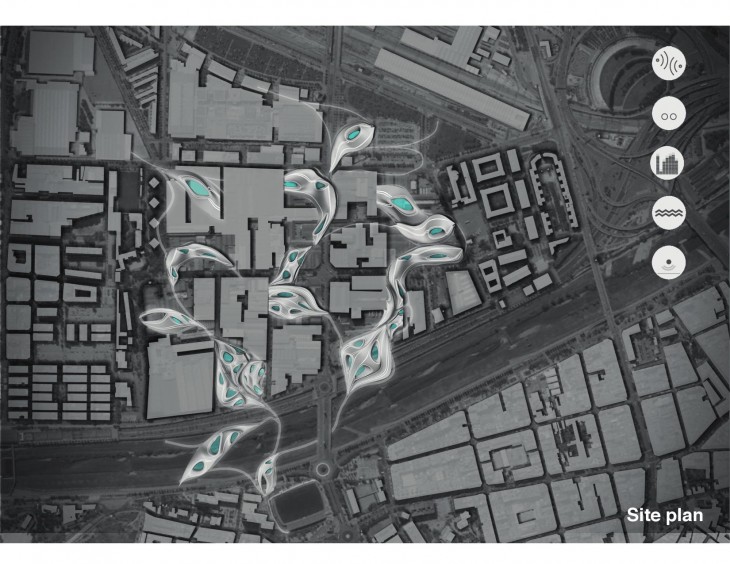 How can we transform POLLUTION into a CELEBRATION? Welcome to Acoustic Ecology: Our project reacts to the fact that throughout the years cities have been designed taking sound as a negative environmental factor. On the other hand we use sound as a parameter of design we experiment with different morphological urban patterns in Santa Coloma that are interactive to real time data. Each component in our landscape has a specific function according to the zoning, using sound as an ABSORBER, DEFLECTOR, and RECORDER which react to sound and blends with landscape in between this post-industrial neighborhood. This representation gives an overall understanding of how the acoustic ecology hacks the industrial area with the different zones of intervention according through the zoning and sound mapping. As a result the landscape is piercing through the industrial area, at the same time that acts like a connector. From now onwards we insist this invisible layer will also be a priority before designing a city. Its effects are as not invisible as its nature itself, but everyday there will be new sounds that will create new adaptive and interactive structures.
How can we transform POLLUTION into a CELEBRATION? Welcome to Acoustic Ecology: Our project reacts to the fact that throughout the years cities have been designed taking sound as a negative environmental factor. On the other hand we use sound as a parameter of design we experiment with different morphological urban patterns in Santa Coloma that are interactive to real time data. Each component in our landscape has a specific function according to the zoning, using sound as an ABSORBER, DEFLECTOR, and RECORDER which react to sound and blends with landscape in between this post-industrial neighborhood. This representation gives an overall understanding of how the acoustic ecology hacks the industrial area with the different zones of intervention according through the zoning and sound mapping. As a result the landscape is piercing through the industrial area, at the same time that acts like a connector. From now onwards we insist this invisible layer will also be a priority before designing a city. Its effects are as not invisible as its nature itself, but everyday there will be new sounds that will create new adaptive and interactive structures. 






 PART 1 “CONNECTIVITY” Santa Coloma de Gramenet is a city in Catalonia, Spain. It is situated on the south-east side of the Litoral range, with the Puig Castellar (299 m) as its highest point; on the left bank of the Besòs River the municipalities of Sant Adrià de Besòs and Badalona separate it from the coast. Santa Coloma has won a lot of awards with respect to sustainability and is quite successful as a city as 80 % of the residents walk within the city. There is an EVIDENT disconnection between both these sides and we started to investigate this issue. “INDUSTRY” Industries have always been a part which is designed along the outskirts of the city to avoid interaction with the city. Due to the urban sprawl along the years in Barcelona the industries have been in the same location and the residential areas have been made around them. In SANT ANDREU certain manufacturing industries have gone into a decline due to various economic factors including the development of replacement technology or the loss of competitive advantage. They were a heavy duty industry which have been converted along the years to suit the surroundings of the site but has not been able to fit in. The environment of this industry is not habitable for the pedestrians or for the residential area around it This became the starting point for a series of urban and spatial zones that occupy and transform the existing grid structure of the post-industrial neighbourhood and converting them into a new ECOLOGY shaped by street noise and other urban sounds.” We want this soundscape to function responsibly for its surrounding neighbourhoods, as well as for the industries.
PART 1 “CONNECTIVITY” Santa Coloma de Gramenet is a city in Catalonia, Spain. It is situated on the south-east side of the Litoral range, with the Puig Castellar (299 m) as its highest point; on the left bank of the Besòs River the municipalities of Sant Adrià de Besòs and Badalona separate it from the coast. Santa Coloma has won a lot of awards with respect to sustainability and is quite successful as a city as 80 % of the residents walk within the city. There is an EVIDENT disconnection between both these sides and we started to investigate this issue. “INDUSTRY” Industries have always been a part which is designed along the outskirts of the city to avoid interaction with the city. Due to the urban sprawl along the years in Barcelona the industries have been in the same location and the residential areas have been made around them. In SANT ANDREU certain manufacturing industries have gone into a decline due to various economic factors including the development of replacement technology or the loss of competitive advantage. They were a heavy duty industry which have been converted along the years to suit the surroundings of the site but has not been able to fit in. The environment of this industry is not habitable for the pedestrians or for the residential area around it This became the starting point for a series of urban and spatial zones that occupy and transform the existing grid structure of the post-industrial neighbourhood and converting them into a new ECOLOGY shaped by street noise and other urban sounds.” We want this soundscape to function responsibly for its surrounding neighbourhoods, as well as for the industries.








